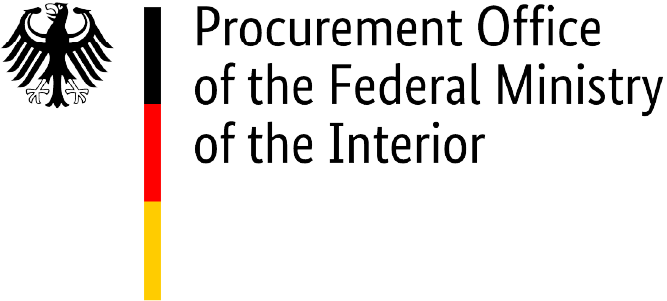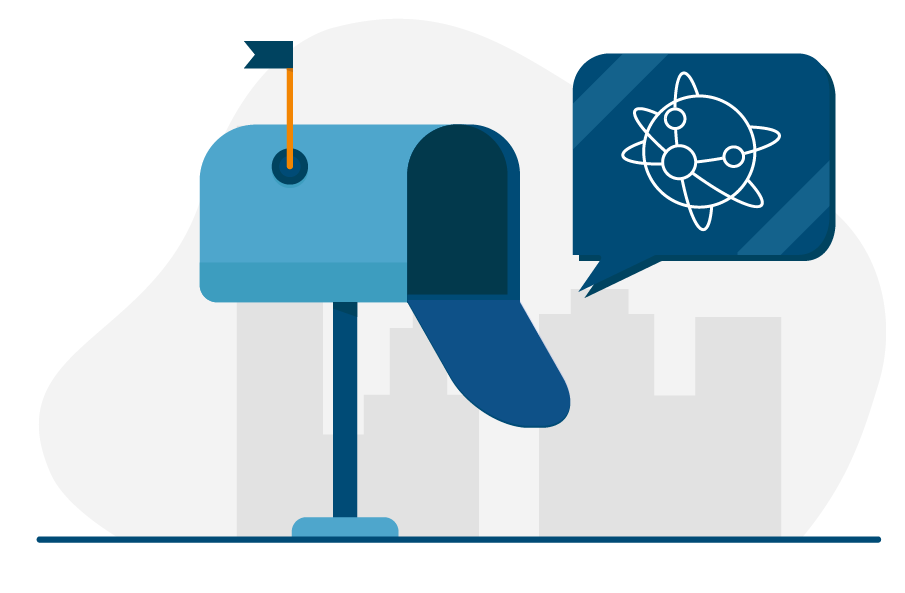Important information: Please note that the federal invoice submission portals, ZRE and OZG-RE, will be consolidated by summer 2025. Following the consolidation, only the OZG-RE will be operated as the sole federal invoice submission portal. The operation of the ZRE will be discontinued as of 31 December 2025. Suppliers will receive all relevant information and the required details for future invoicing directly from the authorities to which they submit invoices. For further details, please refer to this article.
Using the Peppol network for public e‑procurement
The Peppol network was developed by the OpenPeppol non-profit organisation with the aim of enabling smooth, standardised and automated cross-border e-procurement. This includes the transmission of electronic invoices.
The improved efficiency resulting from electronic invoice processing can help increase the liquidity of suppliers.
Why use Peppol as a transmission method for your e‑invoice?
Germany’s federal administration uses two federal submission portals for e-invoices: The ZRE (Central Invoice Submission Portal) which enables all organisations of the direct federal administration to receive e-invoices, and the OZG-RE (Online Access Act-compliant Invoice Submission Portal) which is a service offered to organisations of the indirect federal administration and cooperating federal states. Instead of using the OZG-RE, organisations of the indirect federal administration may also implement their own solutions for receiving e-invoices provided they are compliant with the Ordinance on Electronic Invoicing in Federal Public Procurement (E-RechV).
There are four options available to invoice issuers for transmitting e-invoices to customers who are connected to the federal invoice submission portals ZRE and OZG-RE:
- Sending the invoice via the Peppol network
- Sending the invoice via email
- Uploading the invoice on the web interface
- Entering the invoice manually on the web interface
Unlike the other options, Peppol is the only transmission method which supports automated machine-to-machine (m2m) communication and the mass export of e-invoices.
3 ways to submit your e‑invoices via Peppol
If you choose to submit your invoices via Peppol, you have three different options:
1. Using the federal Peppol web service (Peppol des Bundes)
The federal web service is offered free of charge to invoice issuers, enabling them to transmit their e-invoices via Peppol to the ZRE and OZG-RE federal invoice submission portals. If you wish to use the federal web service, please send an email to peppol.support@nortal.com to request the starter package. To connect to the web service, contact your IT department or an external service provider. Once you are connected, your invoicing clerks will be able to use the service conveniently and free of charge, directly from their own systems.
![]() Advantages
Advantages
- You can use this service free of charge to send your e-invoices to the ZRE and OZG-RE federal invoice submission portals.
- The web service interface can be conveniently used from your own systems.
![]() Disadvantages
Disadvantages
- You will be dependent on the implementation and functionalities of the web service.
- You can only transmit e-invoices in the most recent version of the XRechnung standard, and only to the ZRE and OZG-RE submission portals.
2. Using an existing Peppol service provider
A verified Peppol service provider makes a web service available to you. At Peppol.org you will find a list of Peppol service providers that you can ask for a quote.
![]() Advantages
Advantages
- You can use Peppol flexibly:
- You can also use Peppol to exchange documents other than e-invoices.
- You can send e-invoices and documents not only to the ZRE and OZG-RE portals but also to other systems that are connected to the network.
- It is not necessary to set up an access point of your own, so there will be no additional Peppol access point to add to the complexity of your IT infrastructure.
- No OpenPeppol membership (which is subject to a fee) is required.
- If you conclude a contract with a Peppol-service provider, you have full cost control.
- Network availability is ensured by the service provider.
- You can choose among various providers and pick the offer that suits you best.
![]() Disadvantages
Disadvantages
- You are bound by the costs and technologies of your Peppol service provider.
3. Joining OpenPeppol (subject to a fee) and setting up your own Peppol access point
![]() Advantages
Advantages
- Independence: apart from mandatory requirements that you have to fulfil, your are free to implement your Peppol access point as you see fit.
- You have full control in ensuring that the Peppol access point fits in optimally with your existing IT landscape.
- You can share your access point with other companies, turning it into a source of revenue.
- As a member of OpenPeppol, you can help shape Peppol’s future in technological and organisational terms.
![]() Disadvantages
Disadvantages
There are costs involved:
-
- OpenPeppol membership fees
- costs for setting up a Peppol access point
- operating costs for the Peppol access point
- and other contingent costs
Advantages of Peppol
Peppol enables the fully automated exchange of electronic documents. This means that all participants can seamlessly export and import documents from different processing systems. The Peppol network is designed to transmit high volumes of e-invoices.
Automated invoicing involves additional benefits for suppliers:
Efficiency
For invoicing clerks, transmission via Peppol is the most convenient e-invoicing option because Peppol is directly connected to their ERP system via an interface. Once the technical connection is in place, invoices can be submitted with just a few mouse clicks in your own ERP system. Peppol enables you to process e-invoices seamlessly (machine-to-machine) and conveniently, without having to switch between different systems. Also, you can dispatch large volumes of e-invoices (mass exports).
Quality
Using Peppol to transmit your documents helps to reduce operating errors and increases transparency across the entire invoicing process.
Security
Peppol ensures the highest security standards and compliance with data protection regulations when it comes to the transmission of documents.
Standardisation for cross-border interoperability in procurement and contract award procedures
Introducing uniform and mandatory standards for all participants in the Peppol network significantly facilitates the exchange of documents from different systems.
Peppol requires all participants to apply specific standards for the electronic exchange of documents, which are known as Business Interoperability Specifications (BIS).
Technical details regarding the electronic submission of invoices via Peppol
Standard-compliant e‑invoicing
In general, e-invoices addressed to the federal administration must be issued using the currently valid version of the XRechnung standard. Other standards may be used (such as ZUGFeRD (version 2.1.1 or later) in the XRECHNUNG profile, as a simple structured XML file) as long as they meet the requirements of the European e-invoicing standard (EN 16931), the terms of use for the federal invoice submission portals and the requirements of the Ordinance on Electronic Invoicing in Federal Public Procurement (ERechV). Your ERP system must be able to generate electronic invoices according to these requirements. The Xrechnung standard is operated and maintained by KoSIT (Coordination Office for IT Standards), which also provides a validation tool (KoSIT validator) to check that e-invoices are formally correct. You may use this tool to check your e-invoices before sending them to ensure they are not rejected by the ZRE and OZG-RE federal invoice submission portals. More information is available here: KoSIT (German only)
Using Peppol with an interface to your systems
Using Peppol is particularly easy if your ERP system is able to use Peppol directly via an interface. To implement such a solution, it may be advisable to contact a Peppol service provider, who will also take care of your registration in the Peppol network if necessary so that you can use your personal Peppol sender ID.
Alternatively, you can use the federal web service or set up your own infrastructure for using Peppol. More information is available here: FAQs regarding Peppol
Addressing via Peppol participant ID
In the Peppol network, the Peppol participant identifier serves to clearly identify a given participant; its function is similar to that of a VAT ID or an IBAN in online banking.
A distinction is made between the sender ID (invoice issuer) and the receiver ID (invoice recipient).
In order to transmit an e-invoice via Peppol, you will need the unique Peppol-Receiver-ID of the invoice recipient for addressing purposes. In the federal administration, the Peppol receiver ID is generally composed of the prefix 0204 and the buyer reference (Leitweg-ID) of your customer. You will find the buyer reference in the contract documents; otherwise you can obtain it from your customer upon request.
The buyer reference tells you whether a given invoice recipient receives e-invoices via the ZRE or the OZG-RE portal. If the prefix 991 is used, the invoice recipient is connected to the ZRE portal; if the prefix is 992, the customer is connected to the OZG-RE portal.
The structure of the Peppol participant ID is shown in the list below.
- Peppol Participant ID invoice recipient: 0204:buyer reference (Leitweg-ID)
- Peppol Participant ID invoice issuer: 9930:VAT ID or 0088:Global Location Number
Note: When sending e-invoices via Peppol, please address them in the BIS document (Business Interoperability Specification). The BIS document establishes a clearly defined standard for exchanging documents within the network. Here, you have to enter the invoice recipient’s Peppol receiver ID. In the e-invoice itself, however, you have to enter the buyer reference, otherwise the e-invoice will be rejected by the ZRE and OZG-RE portals.
Submitting your e‑invoice
In order to submit your e-invoices to the federal administration, you currently need to be registered – in accordance with the relevant terms of use – with the federal invoice submission portal that your invoices are addressed to; this applies regardless of the transmission method you choose.
Registration with and use of the ZRE and OZG-RE submission portals are free of charge. You can either tell from the buyer reference which platform is to be addressed or request that information from your customer.
Alternatively, we also offer an overview of the organisations connected to ZRE and OZG-RE, respectively. Since listing is voluntary, some organisations may be missing from the list.
Further information
In the FAQ section on Peppol, you will find further information on this transmission method. Furthermore, you can find explanatory videos on the use of the Peppol network in our library. For specific questions, please use the contact form or the support hotline.

